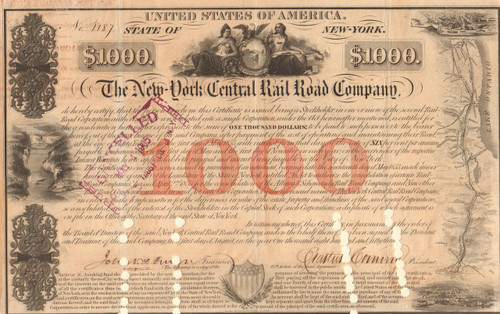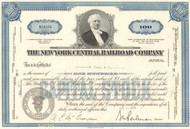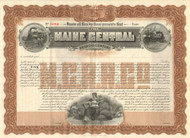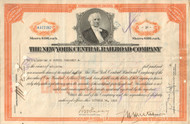Categories
Categories
- Home
- Railroad
- 1800's Railroads
- New York Central Railroad $1000 bond 1853 (Erastus Corning)
New York Central Railroad $1000 bond 1853 (Erastus Corning)
Product Description
New York Central Railroad $1000 bond certificate 1853 (Erastus Corning as president)
Great historical bond with multiple vignettes of the NY state seal and a view of the Hudson River. Issued and cancelled. Dated 1853. Signed by Erastus Corning as president (cancellation holes as pictured).
Erastus Corning (1794-1872), prominent in railroad development in the state of New York. He became the first President of the New York Central in 1853. He was four times elected Mayor of Albany and twice as a Democratic Representative in Congress.
Erastus Corning's most lasting contribution to history may have been his dealings with railroads. When the Utica and Schenectady Railroad was chartered in 1833, Corning got himself a seat on the board and became a major investor, and was soon president of the road. Corning ran the Utica & Schenectady for twenty years. The railroad eventually boasted 78 miles (126 km) of track, from Schenectady in the east (where the road interchanged with the smaller Mohawk and Hudson Railroad of which Corning was also a shareholder) to Utica in the west. In 1851, the road's name was changed to the Mohawk Valley Railroad. As president of the Utica & Schenectady, Corning organized in 1851 a convention of the owners and presidents of the other eight operating railroads, which combined roughly connected the cities of Albany and Buffalo, New York. The convention agreed on a framework for consolidation of the eight roads (as well as two "paper" roads, which had not yet been built but were planned), and Corning took the convention's application to the state Legislature. Corning became the main lobbyist for the proposal in the legislature, and despite being a Democrat made a personal appeal to Thurlow Weed, leader of the Whigs, who controlled state government at the time.
Corning had a lot riding on the legislature's decision. He had organized the convention and largely dictated the terms of the merger to the other companies. Once the legislature passed the Consolidation Act on April 2, 1853, Corning found himself in possession of the majority of shares in the new company, and so at the first meeting of the New York Central's shareholders in 1853, Corning got himself elected president of the company. He remained in that role for twelve years, during which time the New York Central made connections and struck deals that gave the road access to Cleveland, Boston, New York City, and Chicago, and made it one of the country's most important railroads.
NY Central RR
The New York Central Railroad operated in the northeastern and midwestern United States. Headquartered in New York City, the New York Central was a large railroad, and it had several subsidiaries whose identity remained strong in local loyalties.
In broad geographic terms, the New York Central proper was everything east of Buffalo plus a line from Buffalo through Cleveland and Toledo to. NYC included the Ohio Central Lines and the Boston & Albany Railroad. The Michigan Central Railroad was a Buffalo-Detroit-Chicago line and everything in Michigan north of that. NYC's Grand Central Terminal in New York City is one of its best known extant landmarks.
In 1851 the state passed an act freeing the railroads from the need to pay tolls to the Erie Canal, with which they competed; that same year the Hudson River Railroad was opened from New York City to Rensselaer and the New York & Erie (later the Erie Railroad) was opened from Piermont, on the Hudson River, west to Dunkirk, New York, on Lake Erie. The New York & Harlem Railroad (NY&H) was incorporated in 1831 to build a line in Manhattan from 23rd Street north to 129th Street between Third and Eighth Avenues. In 1844 the rails reached White Plains and in January 1852 the NY&H made connection with the Western Railroad .
On July 6, 1853, ten railroads stretching 298 miles from Buffalo to Albany were consolidated as the New York Central Railroad. The president of the new railroad was Erastus Corning, the former mayor of Albany and president of the Utica and Schenectady Railroad. By 1863 Cornelius Vanderbilt controlled the NY&H and had acquired a substantial interest in the Hudson River Railroad. In 1867 he obtained control of the New York Central, consolidating it with the Hudson River in 1869 to form the New York Central & Hudson River Railroad
The Great Western Railway opened in 1854 from Niagara Falls to Windsor, Ontario, opposite Detroit, and in March 1855 John Roebling's suspension bridge across the Niagara River was completed, creating with the NYC a continuous line of rails from Albany to Windsor. Vanderbilt, who had started buying MC stock in 1869, tried to purchase the Great Western. He did not succeed and turned his attention instead to the Canada Southern Railway. It had been incorporated in 1868 as the Erie & Niagara Extension Railway to build a line along the north shore of Lake Erie and then across the Detroit River below the city of Detroit. He acquired the railroad in 1876; MC leased it in 1882. Conrail sold the Canada Southern to Canadian National and Canadian Pacific in 1985. NYC leased the MC in 1930.
The New York Central System was the final name change, which took place in the summer of 1935. The NYCS was the largest of the eastern trunk systems from the standpoint of mileage and second only to the PRR in revenue. NYC did not share as fully in the post–World War II economic expansion because of rising labor and material costs and an extensive improvement program, especially for passenger services. Despite having several modern steam locomotives, NYC's poor financial position caused it to convert to more economical diesel-electric power rapidly.
Planning and justifying the merger took nearly a decade, during which time the eastern railroad scene had changed radically, in large measure because of the impending merger of NYC and PRR. The Erie merged with the DL&W to create the Erie Lackawanna Railway (EL) in 1960, C&O acquired control of B&O, and N&W took in the Virginian Railway, Wabash, Nickel Plate, Pittsburgh & West Virginia and Akron, Canton & Youngstown. Stockholders of the PRR and NYC approved the merger of the two railroads on May 8, 1962. ICC approved the merger four years later, and on February 1, 1968, the Penn Central (PC) came into existence — and fell apart faster than it went together.
 Loading... Please wait...
Loading... Please wait... 











